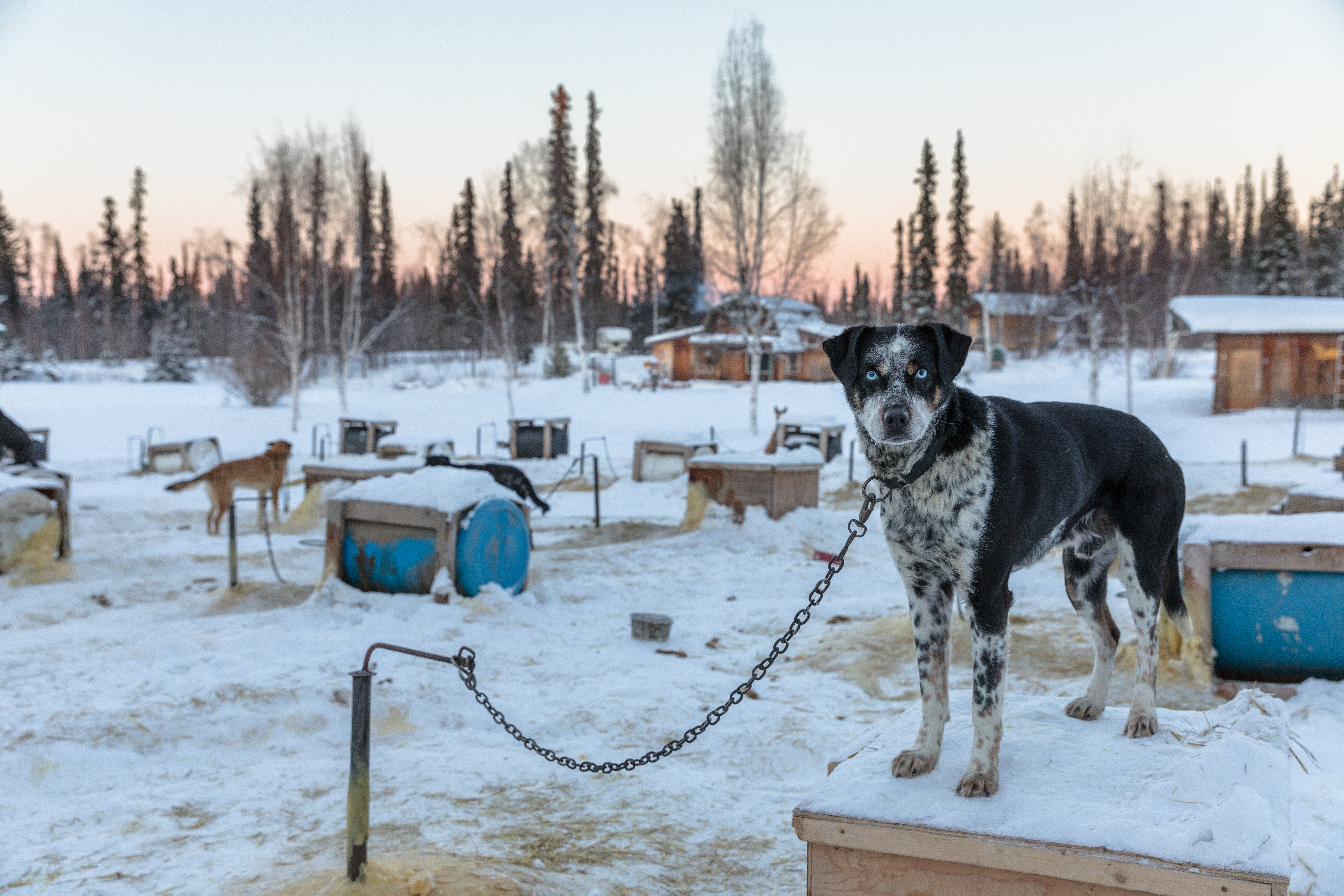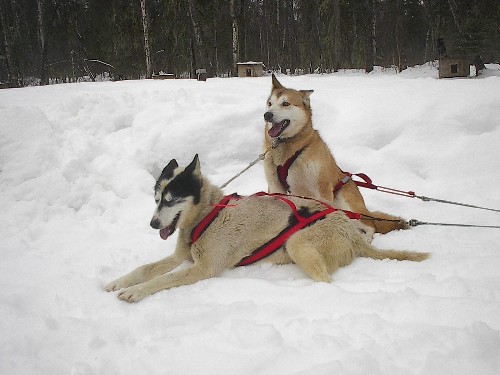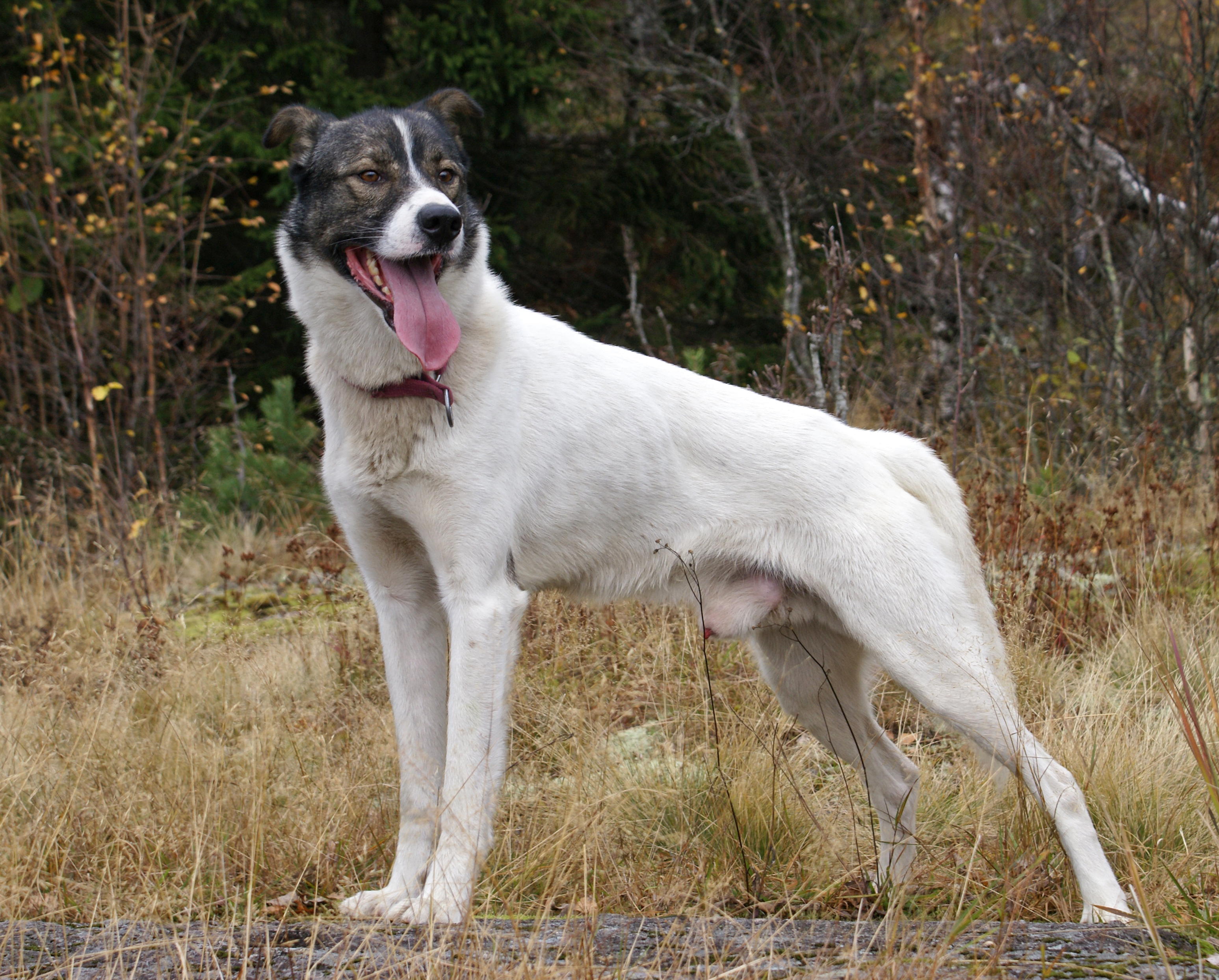Alaskan Husky on:
[Wikipedia]
[Google]
[Amazon]
The Alaskan husky is a breed of medium-sized working sled dog, developed specifically for its performance as such.
Alaskan huskies are the most commonly used type of dog for competitive sled dog racing, both in short-distance sprint racing as well as long-distance expedition races such as the Iditarod Trail Sled Dog Race, the Yukon Quest, and the Finnmarkslopet.
 The Alaskan husky is an incredibly athletic dog variety, and as a dog crossbreed their appearance can vary markedly, although various lines have been bred for multiple generations and breed very true to that line's type. Some Alaskan husky lines have very traditional husky spitz-like features with pricked ears and curled tails, whilst other lines more closely resemble their
The Alaskan husky is an incredibly athletic dog variety, and as a dog crossbreed their appearance can vary markedly, although various lines have been bred for multiple generations and breed very true to that line's type. Some Alaskan husky lines have very traditional husky spitz-like features with pricked ears and curled tails, whilst other lines more closely resemble their

 In the latter half of the 20th century the primary use of sled dogs shifted from utility to sport, particularly career competitive sled dog racing. In order to facilitate greater speed for racing sport, various breeds of gundogs and
In the latter half of the 20th century the primary use of sled dogs shifted from utility to sport, particularly career competitive sled dog racing. In order to facilitate greater speed for racing sport, various breeds of gundogs and
Description
The Alaskan husky is not an officially recognized breed by any kennel club, nor does it have a formal breed standard. Unlike breeds developed for the show ring, the Alaskan husky is instead a product of careful selection for desirable sled dog traits from various other breeds, such as aptitude for pulling, endurance, speed, intelligence, appetite, and tolerance of extreme weather. As a result of this specific and mindful performance-only based breeding, DNA studies show that Alaskan Huskies share a genetic signature and indeed can be identified accurately on DNA breed tests. The Alaskan husky is an incredibly athletic dog variety, and as a dog crossbreed their appearance can vary markedly, although various lines have been bred for multiple generations and breed very true to that line's type. Some Alaskan husky lines have very traditional husky spitz-like features with pricked ears and curled tails, whilst other lines more closely resemble their
The Alaskan husky is an incredibly athletic dog variety, and as a dog crossbreed their appearance can vary markedly, although various lines have been bred for multiple generations and breed very true to that line's type. Some Alaskan husky lines have very traditional husky spitz-like features with pricked ears and curled tails, whilst other lines more closely resemble their hound
A hound is a type of hunting dog used by hunters to track or chase prey.
Description
Hounds can be contrasted with gun dogs that assist hunters by identifying prey and/or recovering shot quarry. The hound breeds were the first hunting dogs. ...
or gundog heritage with tipped or floppy ears, straight tails and tucked up sighthound
Sighthounds, also called gazehounds, are a type of dog, hounds that hunt primarily by sight and speed, rather than by scent and endurance as scent hounds do.
Appearance
These dogs specialize in pursuing prey, keeping it in sight, and overp ...
-like loins. As they are not bred with conformation in mind, cosmetic features are not a consideration for breeding, and these features instead tend to follow the purpose of the dog's intended style of sled work.
Generally Alaskan huskies are taller than Siberian Huskies and are lighter in build than Alaskan Malamutes, both of whom they share lineage with and are descended from. On average they stand between and weigh between . Tough feet are an important feature and desirable trait for breeding consideration. As with their build, the Alaskan husky's coat can vary greatly; they usually have double coats with all colors and patterns of colors seen within various lines. Distance-type Alaskan huskies often have denser double coats to better contend with cold temperatures and harsh wind, whereas sprint lines have shorter coats to allow for greater heat dissipation during races at high speeds.
It is common for distance-type Alaskan huskies to be outfitted with dog coats and dog booties during long expeditions and races, in order to regulate temperature and protect the dog's feet from ice and rough terrain. The use of dog coats has become more common into the late 20th and early 21st centuries as even the distance lines have been bred for greater speed, sacrificing some of the heavier and more dense protective double-coat of their Arctic
The Arctic ( or ) is a polar regions of Earth, polar region located at the northernmost part of Earth. The Arctic consists of the Arctic Ocean, adjacent seas, and parts of Canada (Yukon, Northwest Territories, Nunavut), Danish Realm (Greenla ...
breed ancestors.
History
As European traders and settlers arrived in Alaska they sought local entertainment, and turned to racing the local means of transportation, sled dogs. Aboriginal dogs found throughoutAlaska
Alaska ( ; russian: Аляска, Alyaska; ale, Alax̂sxax̂; ; ems, Alas'kaaq; Yup'ik: ''Alaskaq''; tli, Anáaski) is a state located in the Western United States on the northwest extremity of North America. A semi-exclave of the U ...
were renowned for their great strength and stamina, but lacked speed, so various outcrosses to fleeter Old World breeds were utilized to produce faster-running dogs, including Siberian
Siberia ( ; rus, Сибирь, r=Sibir', p=sʲɪˈbʲirʲ, a=Ru-Сибирь.ogg) is an extensive geographical region, constituting all of North Asia, from the Ural Mountains in the west to the Pacific Ocean in the east. It has been a part of ...
imports who dominated local organized races in Alaska. Since the beginning of the 20th century, various breeders have turned to various outcrosses to produce different lines of racing dogs. Most lines today contain some form of traditional husky heritage in their bloodlines, Alaskan Malamutes and Siberian Huskies being the most common, although Mackenzie River huskies, Greenland Dogs, and Samoyeds have also been utilized.
 In the latter half of the 20th century the primary use of sled dogs shifted from utility to sport, particularly career competitive sled dog racing. In order to facilitate greater speed for racing sport, various breeds of gundogs and
In the latter half of the 20th century the primary use of sled dogs shifted from utility to sport, particularly career competitive sled dog racing. In order to facilitate greater speed for racing sport, various breeds of gundogs and sighthound
Sighthounds, also called gazehounds, are a type of dog, hounds that hunt primarily by sight and speed, rather than by scent and endurance as scent hounds do.
Appearance
These dogs specialize in pursuing prey, keeping it in sight, and overp ...
s have now been bred into Alaskan husky lines, including Pointers, Greyhound
The English Greyhound, or simply the Greyhound, is a breed of dog, a sighthound which has been bred for coursing, greyhound racing and hunting. Since the rise in large-scale adoption of retired racing Greyhounds, the breed has seen a resurgenc ...
s, German Shorthaired Pointers, Saluki
The Saluki, also known as the Persian Greyhound, is a standardised breed developed from sighthounds – dogs that hunt primarily by sight rather than scent – that was once used by nomadic tribes to run down game animals. The dog was origin ...
s, Borzois, Labradors and Setter
The setter is a type of gundog used most often for hunting game such as quail, pheasant, and grouse.
In the UK, the four setter breeds, together with the pointers, usually form a subgroup within the gundog group as they share a common ...
s; some breeders have even used wolves
The wolf (''Canis lupus''; : wolves), also known as the gray wolf or grey wolf, is a large canine native to Eurasia and North America. More than thirty subspecies of ''Canis lupus'' have been recognized, and gray wolves, as popularly un ...
at various points.
Lineage
Genetic studies indicate that the Alaskan Husky originates from pre-Colonial North American Arctic village dogs (including precursors to the Alaskan Malamute) and Siberian imports (precursors to the Siberian Husky), crossbred with European breeds such as Pointers, German Shepherd Dogs, and Salukis to improve its performance. In 2015, a DNA study indicated that the Alaskan husky, the Siberian Husky, and theAlaskan Malamute
The Alaskan Malamute () is a large breed of dog that was originally bred for its strength and endurance to haul heavy freight as a sled dog and hound. It is similar to other arctic breeds such as the husky, the spitz, the Greenland Dog, Canadi ...
share a close genetic relationship between each other and were related to Chukotka sled-dogs from Siberia
Siberia ( ; rus, Сибирь, r=Sibir', p=sʲɪˈbʲirʲ, a=Ru-Сибирь.ogg) is an extensive geographical region, constituting all of North Asia, from the Ural Mountains in the west to the Pacific Ocean in the east. It has been a part ...
. They were separate to the two Inuit dogs: the Canadian Eskimo Dog
The Canadian Eskimo Dog or Canadian Inuit Dog is a breed of working dog from the Arctic. Other names include ''qimmiq''Greenland Dog. The Siberian Husky and the Malamute both had maintained their Siberian lineage and had contributed significantly to the Alaskan husky, which was developed through crossing with 
 The Alaskan husky has selectively been bred specifically for its athletic performance. As such, its level of athletic ability, as well as
The Alaskan husky has selectively been bred specifically for its athletic performance. As such, its level of athletic ability, as well as  Like most working sled dogs, Alaskan huskies are capable of pulling far greater than their own body weight in load while in harness. Sprint teams of Alaskan huskies are capable of speeds of up to 28 mph (45 km/h), whereas distance-specialist teams have completed 938 mile (1510 km) races in just 8 days, 3 hours, 40 minutes, and 13 seconds with time including 40 hours of mandatory rests and other routine rests on the trail.
As specifically purposed working sled dogs, Alaskan huskies can be subject to climate or work-specific health conditions that any sled dogs may experience, such as temperature-related
Like most working sled dogs, Alaskan huskies are capable of pulling far greater than their own body weight in load while in harness. Sprint teams of Alaskan huskies are capable of speeds of up to 28 mph (45 km/h), whereas distance-specialist teams have completed 938 mile (1510 km) races in just 8 days, 3 hours, 40 minutes, and 13 seconds with time including 40 hours of mandatory rests and other routine rests on the trail.
As specifically purposed working sled dogs, Alaskan huskies can be subject to climate or work-specific health conditions that any sled dogs may experience, such as temperature-related
Europe
Europe is a large peninsula conventionally considered a continent in its own right because of its great physical size and the weight of its history and traditions. Europe is also considered a Continent#Subcontinents, subcontinent of Eurasia ...
an breeds.
Other breeds identified as having contributed to the Alaskan husky sled dog gene pool include Pointers, and a number of other non-arctic breeds by breed and type group. Genetic variation in the Alaskan husky has been analyzed based on the groupings of two purpose-driven distinct populations within the Alaskan sled dog gene pool: A distance group, and a sprint group:
* The distance group showed a higher contribution from the Arctic/Asian group, mainly the Siberian Husky and Alaskan Malamute, and the Mastiff/Terrier group consisting primarily of Great Pyrenees
The Pyrenean Mountain Dog
(french: Chien de Montagne des Pyrénées) is a breed of livestock guardian dog from France, where it is commonly called the Patou. The breed comes from the French side of the Pyrenees Mountains that separate France ...
and Anatolian Shepard. The distance group also showed to be more genetically distinct from one another across kennel-based populations and at the individual level, than the sprint group.
*The sprint group displayed a higher contribution from Pointer-type dogs and Salukis, and the lowest contribution from Siberian Huskies and Alaskan Malamutes, as well as the extreme-sprint specialists displaying the highest contribution from already long-bred Alaskan husky lineage.
*A sub-group chosen for analysis due to its overlap between distance and sprint types displayed the most Saluki contribution, more than the extreme sprint or extreme distance specialists.
Health and Physical Capabilities
 The Alaskan husky has selectively been bred specifically for its athletic performance. As such, its level of athletic ability, as well as
The Alaskan husky has selectively been bred specifically for its athletic performance. As such, its level of athletic ability, as well as anabolic
Anabolism () is the set of metabolic pathways that construct molecules from smaller units. These reactions require energy, known also as an endergonic process. Anabolism is the building-up aspect of metabolism, whereas catabolism is the breakin ...
efficiency are far greater than the average domesticated dog, especially in endurance feats. Distance-specialist Alaskan huskies out-speed most animals and all other types of sled dogs when running distances of 50 miles or greater, even while pulling moderately sized loads. Studies on the metabolic capabilities in working Alaskan husky sled dogs reveal that their system transitions to utilization of low-glucose energy sources (from high-glycogen carbohydrates) early on during long periods of travel, and their reliance on these low-glucose fuels (such as those higher in fats and proteins) continue and even extend to become more pronounced after working for longer periods. A good appetite is a highly desirable trait, and is emphasized in breeding choices.
 Like most working sled dogs, Alaskan huskies are capable of pulling far greater than their own body weight in load while in harness. Sprint teams of Alaskan huskies are capable of speeds of up to 28 mph (45 km/h), whereas distance-specialist teams have completed 938 mile (1510 km) races in just 8 days, 3 hours, 40 minutes, and 13 seconds with time including 40 hours of mandatory rests and other routine rests on the trail.
As specifically purposed working sled dogs, Alaskan huskies can be subject to climate or work-specific health conditions that any sled dogs may experience, such as temperature-related
Like most working sled dogs, Alaskan huskies are capable of pulling far greater than their own body weight in load while in harness. Sprint teams of Alaskan huskies are capable of speeds of up to 28 mph (45 km/h), whereas distance-specialist teams have completed 938 mile (1510 km) races in just 8 days, 3 hours, 40 minutes, and 13 seconds with time including 40 hours of mandatory rests and other routine rests on the trail.
As specifically purposed working sled dogs, Alaskan huskies can be subject to climate or work-specific health conditions that any sled dogs may experience, such as temperature-related bronchitis
Bronchitis is inflammation of the bronchi (large and medium-sized airways) in the lungs that causes coughing. Bronchitis usually begins as an infection in the nose, ears, throat, or sinuses. The infection then makes its way down to the bronchi. ...
or bronchopulmonary ailments, also known as "ski asthma".
In 2020, the largest study of "canine hematologic and serum biochemical analytes" to date was published, including within it the largest data set of healthy athlete dogs; the dogs of reference were 4,804 sled dogs training for the Iditarod Trail Sled Dog Race, the overwhelming majority of which were Alaskan huskies. The study found that anti-aging and anti-inflammatory biochemical levels in the dogs increased over time and with training, enhancing the dogs' physical and mental abilities until an average of 6.6 years of age. Despite noted differences in sex, genetic, and age groups in other areas, they were not statistically significant and were outside the scope of the study, making them scientifically inconclusive despite their observance.
Behavior
The behaviors and temperament of the Alaskan husky can vary greatly due to the wide range of genetic backgrounds and bred-purposes within the breed. As with all sled dogs, a desire to pull and run are essential and are of high priority in decisions of breeding. Mental soundness is also important due to the need for dogs to be in close quarters with other dogs while hooked in the team, handled by people for proper care and transportation, and for dogs on racing teams to perform under environments which include trails crowded with spectators and other dog teams. As dogs selectively-bred for their ability as working sled dogs without direct physical feedback from the driver, intelligence and problem solving are highly desired in a specimen and are often marks of talented lead dogs, which are often those with the highest consideration as breeding prospects. Dogs are expected to read the trail and situation through instincts and experience, and thus superior cognitive abilities are often bred into Alaskan husky lines in tandem with physical athletic attributes.References
{{Spitz Sled dogs